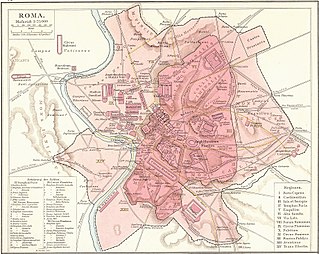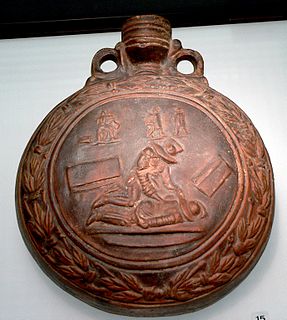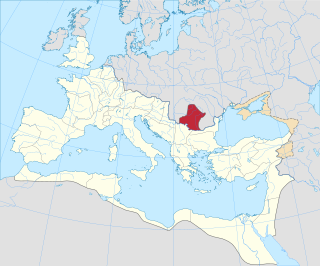
A gladiator was an armed combatant who entertained audiences in the Roman Republic and Roman Empire in violent confrontations with other gladiators, wild animals, and condemned criminals. Some gladiators were volunteers who risked their lives and their legal and social standing by appearing in the arena. Most were despised as slaves, schooled under harsh conditions, socially marginalized, and segregated even in death.

Trajan was Roman emperor from 98 to 117. Officially declared by the Senate optimus princeps, Trajan is remembered as a successful soldier-emperor who presided over the second-greatest military expansion in Roman history, after Augustus, leading the empire to attain its maximum territorial extent by the time of his death. He is also known for his philanthropic rule, overseeing extensive public building programs and implementing social welfare policies, which earned him his enduring reputation as the second of the Five Good Emperors who presided over an era of peace within the Empire and prosperity in the Mediterranean world.

The Colosseum, is an oval amphitheatre in the centre of the city of Rome, Italy, just east of the Roman Forum and is the largest ancient amphitheatre ever built, and is still the largest standing amphitheater in the world today, despite its age. Construction began under the emperor Vespasian in 72 and was completed in AD 80 under his successor and heir, Titus. Further modifications were made during the reign of Domitian. The three emperors that were patrons of the work are known as the Flavian dynasty, and the amphitheatre was named the Flavian Amphitheatre by later classicists and archaeologists for its association with their family name (Flavius).

Moesia was an ancient region and later Roman province situated in the Balkans south of the Danube River. It included most of the territory of modern-day Central Serbia, Kosovo and the northern parts of North Macedonia, the whole of Northern Bulgaria, Romanian Dobruja and small parts of Southern Ukraine.

Sarmizegetusa Regia, also Sarmisegetusa, Sarmisegethusa, Sarmisegethuza, Ζαρμιζεγεθούσα (Zarmizegethoúsa) or Ζερμιζεγεθούση (Zermizegethoúsē), was the capital and the most important military, religious and political centre of the Dacians before the wars with the Roman Empire. Erected on top of a 1200 m high mountain, the fortress, comprising six citadels, was the core of a strategic defensive system in the Orăştie Mountains.

The Dacians were a Thracian people who were the ancient inhabitants of the cultural region of Dacia, located in the area near the Carpathian Mountains and west of the Black Sea. This area includes mainly the present-day countries of Romania and Moldova, as well as parts of Ukraine, Eastern Serbia, Northern Bulgaria, Slovakia, Hungary and Southern Poland. The Dacians spoke the Dacian language, a sub-group of Thracian, but were somewhat culturally influenced by the neighbouring Scythians and by the Celtic invaders of the 4th century BC.

Decebalus and sometimes referred to as Diurpaneus was the last king of Dacia. He is famous for fighting three wars, with varying success, against the Roman Empire under two emperors. After raiding south across the Danube, he defeated a Roman invasion in the reign of Domitian, securing a period of independence during which Decebalus consolidated his rule.

The naumachia in the Ancient Roman world referred to both the staging of naval battles as mass entertainment, and the basin or building in which this took place.

The so-called Free Dacians is the name given by some modern historians to those Dacians who putatively remained outside, or emigrated from, the Roman Empire after the emperor Trajan's Dacian Wars. Dio Cassius named them Dakoi prosoroi meaning "neighbouring Dacians".

The Milliarium Aureum, also known by the translation Golden Milestone, was a monument, probably of marble or gilded bronze, erected by the Emperor Caesar Augustus near the Temple of Saturn in the central Forum of Ancient Rome. All roads were considered to begin at this monument and all distances in the Roman Empire were measured relative to it. On it perhaps were listed all the major cities in the empire and distances to them, though the monument's precise location and inscription remain matters of debate among historians.

The Ludus Magnus was the largest of the gladiatorial schools in Rome. It was built by the emperor Domitian in the late first century C.E., alongside other building projects undertaken by him such as three other gladiatorial schools across the Roman Empire. The training school is situated directly east of the Colosseum in the valley between the Esquiline and the Caelian hills, an area already occupied by Republican and Augustan structures. While there are remains that are visible today, they belong to a reconstruction that took place under the emperor Trajan where the Ludus plane was raised by about 1.5 metres. The Ludus Magnus was essentially a gladiatorial arena where gladiators from across the Roman Empire would live, eat, and practice while undergoing gladiatorial training in preparation for fighting at the gladiatorial games held at the Colosseum.

The Thraex, or Thracian, was a type of Roman gladiator, armed in the Thracian style with a small rectangular, square or circular shield called a parmula and a very short sword with a slightly curved blade called a sica, intended to maim an opponent's unarmoured back. His other armour included armoured greaves, a protective belt above a loin cloth, and a helmet with a side plume, visor and high crest.

The sica was a short sword or large dagger of ancient Thracians, Dacians and Illyrians, used in Ancient Rome too, originating in the Halstatt culture. It was originally depicted as a curved sword and many examples have been found in what are today Albania, Bosnia, Bulgaria, Serbia and Romania. It is also depicted on Trajan's Column; notably the Dacian king Decebalus is depicted committing suicide with one.

The Decebalus Treasure is written by Cassius Dio concerning events said to have happened in the Roman world during the 2nd century AD.
The gens Ceionia or Caeionia was an ancient Roman family of imperial times. The first member of the gens to obtain the consulship was Lucius Ceionius Commodus in AD 78. The rise of this family culminated in the elevation of the emperor Lucius Verus, born Lucius Ceionius Commodus, in AD 161.
The Battle of Sarmizegetusa was a siege of Sarmizegetusa, the capital of Dacia, fought in 106 between the army of the Roman Emperor Trajan, and the Dacians led by King Decebalus.

Roman Dacia was a province of the Roman Empire from 106 to 271–275 AD. Its territory consisted of what are now the regions of Oltenia, Transylvania and Banat. During Roman rule, it was organized as an imperial province on the borders of the empire. It is estimated that the population of Roman Dacia ranged from 650,000 to 1,200,000. It was conquered by Trajan (98–117) after two campaigns that devastated the Dacian Kingdom of Decebalus. However, the Romans did not occupy its entirety; Crișana, Maramureș, and most of Moldavia remained under the Free Dacians.

The Regio III Isis et Serapis was the third regio of imperial Rome, under Augustus's administrative reform. Regio III took its name from the double sanctuary of Isis and Serapis, in the area of the Via Praenestina, containing the valley that was to be the future site of the Colosseum, and parts of the Oppian and Esquiline hills.
Dacicus is a Latin word for "Dacian". It may also mean one of the following:
















